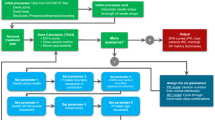Abstract
To investigate how the dwell time deviation constraint (DTDC) parameter, applied to inverse planning by simulated annealing (IPSA) optimisation limits large dwell times from occurring in each catheter and to characterise the effect on the resulting dosimetry for prostate high dose rate (HDR) brachytherapy treatment plans. An unconstrained IPSA optimised treatment plan, using the Oncentra Brachytherapy treatment planning system (version 4.3, Nucletron an Elekta company, Elekta AB, Stockholm, Sweden), was generated for 20 consecutive HDR prostate brachytherapy patients, with the DTDC set to zero. Successive constrained optimisation plans were also created for each patient by increasing the DTDC parameter by 0.2, up to a maximum value of 1.0. We defined a “plan modulation index”, to characterise the change of dwell time modulation as the DTDC parameter was increased. We calculated the dose volume histogram indices for the PTV (D90, V100, V150, V200%) and urethra (D10%) to characterise the effect on the resulting dosimetry. The average PTV D90% decreases as the DTDC is applied, on average by only 1.5 %, for a DTDC = 0.4. The measures of high dose regions in the PTV, V150 and V200%, increase on average by less than 5 and 2 % respectively. The net effect of DTDC on the modulation of dwell times has been characterised by the introduction of the plan modulation index. DTDC applied during IPSA optimisation of HDR prostate brachytherapy plans reduce the occurrence of large isolated dwell times within individual catheters. The mechanism by which DTDC works has been described and its effect on the modulation of dwell times has been characterised. The authors recommend using a DTDC parameter no greater than 0.4 to obtain a plan with dwell time modulation comparable to a geometric optimised plan. This yielded on average a 1.5 % decrease in PTV coverage and an acceptable increase in V150%, without compromising the urethral dose.







Similar content being viewed by others
References
Hoskin PJ, Colombo A, Henry A et al (2013) GEC/ESTRO recommendations on high dose rate afterloading brachytherapy for localised prostate cancer: an update. Radiother Oncol 107:325–332
Rivard MJ, Venselaar JL, Beaulieu L (2009) The evolution of brachytherapy treatment planning. Med Phys 36:2136–2153
Vicini F, Vargas C, Gustafson G et al (2003) High dose rate brachytherapy in the treatment of prostate cancer. World J Urol 21:220–228
Hsu IC, Lessard E, Weinberg V et al (2004) Comparison of inverse planning simulated annealing and geometrical optimization for prostate high-dose-rate brachytherapy. Brachytherapy. 3:147–152
Citrin D, Ning H, Guion P et al (2005) Inverse treatment planning based on MRI for HDR prostate brachytherapy. Int J Radiat Oncol Biol Phys 61:1267–1275
Morton GC, Sankreacha R, Halina P et al (2008) A comparison of anatomy-based inverse planning with simulated annealing and graphical optimization for high-dose-rate prostate brachytherapy. Brachytherapy. 7:12–16
Lessard E, Pouliot J (2001) Inverse planning anatomy-based dose optimization for HDR-brachytherapy of the prostate using fast simulated annealing algorithm and dedicated objective function. Med Phys 28:773–779
Jacob D, Raben A, Sarkar A et al (2008) Anatomy-based inverse planning simulated annealing optimization in high-dose-rate prostate brachytherapy: significant dosimetric advantage over other optimization techniques. Int J Radiat Oncol Biol Phys 72:820–827
Kolkman-Deurloo IK, Visser AG, Niel CG et al (1994) Optimization of interstitial volume implants. Radiother Oncol 31:229–239
Kim Y, Hsu IC, Lessard E et al (2004) Dosimetric impact of prostate volume change between CT-based HDR brachytherapy fractions. Int J Radiat Oncol Biol Phys 59:1208–1216
Hoskin PJ, Bownes PJ, Ostler P et al (2003) High dose rate afterloading brachytherapy for prostate cancer: catheter and gland movement between fractions. Radiother Oncol 68:285–288
Fox CD, Kron T, Leahy M et al (2011) Interfraction patient motion and implant displacement in prostate high dose rate brachytherapy. Med Phys 38:5838–5843
Damore SJ, Syed AM, Puthawala AA et al (2000) Needle displacement during HDR brachytherapy in the treatment of prostate cancer. Int J Radiat Oncol Biol Phys 46:1205–1211
Tiong A, Bydder S, Ebert M et al (2010) A small tolerance for catheter displacement in high-dose rate prostate brachytherapy is necessary and feasible. Int J Radiat Oncol Biol Phys 76:1066–1072
Whitaker M, Hruby G, Lovett A et al (2011) Prostate HDR brachytherapy catheter displacement between planning and treatment delivery. Radiother Oncol 101:490–494
Nucletron an Elekta company EA, Stockholm, Sweden. Oncentra Brachy v4.3 Physics and Algorithms. 2013. Section 7.5.6.13, p 7–52
Karabis A, Giannouli S, Baltas D (2005) HIPO: a hybrid inverse treatment planning optimization algorithm in HDR brachytherapy. Radioth Oncol. 76:S29
Mavroidis P, Katsilieri Z, Kefala V et al (2010) Radiobiological evaluation of the influence of dwell time modulation restriction in HIPO optimized HDR prostate brachytherapy implants. J Contemp Brachytherapy. 2:117–128
Yamada Y, Rogers L, Demanes DJ et al (2012) American Brachytherapy Society consensus guidelines for high-dose-rate prostate brachytherapy. Brachytherapy. 11:20–32
Hsu IC, Bae K, Shinohara K et al (2010) Phase II trial of combined high-dose-rate brachytherapy and external beam radiotherapy for adenocarcinoma of the prostate: preliminary results of RTOG 0321. Int J Radiat Oncol Biol Phys 78:751–758
Zamboglou N, Tselis N, Baltas D et al (2013) High-dose-rate interstitial brachytherapy as monotherapy for clinically localized prostate cancer: treatment evolution and mature results. Int J Radiat Oncol Biol Phys 85:672–678
Author information
Authors and Affiliations
Corresponding author
Rights and permissions
About this article
Cite this article
Smith, R.L., Panettieri, V., Lancaster, C. et al. The influence of the dwell time deviation constraint (DTDC) parameter on dosimetry with IPSA optimisation for HDR prostate brachytherapy. Australas Phys Eng Sci Med 38, 55–61 (2015). https://doi.org/10.1007/s13246-014-0317-2
Received:
Accepted:
Published:
Issue Date:
DOI: https://doi.org/10.1007/s13246-014-0317-2




